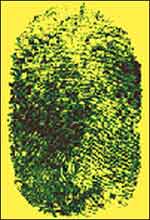Computerized fingerprint matching is highly accurate

Computerized fingerprint <br><br>
Computerized systems that automatically match fingerprints have become so sophisticated that the best of them are accurate more than 99 percent of the time, according to the most comprehensive known study of the systems ever conducted.
Computer scientists at the Commerce Department’s National Institute of Standards and Technology (NIST) tested 34 commercially available systems provided by 18 companies from around the world. NIST conducted the testing to evaluate the accuracy of fingerprint matching for identification and verification systems.
While law enforcement agencies long have employed automated fingerprint matching devices, they are used increasingly in biometric systems to make national borders more secure. NIST conducted the study to fulfill requirements of the USA PATRIOT Act and the Enhanced Border Security and Visa Entry Reform Act.
The test used operational fingerprints from a variety of U.S. and state government sources. A total of 48,105 sets of fingerprints from 25,309 people, with a total of 393,370 distinct fingerprint images, were used to enable thorough testing.
The most accurate systems were from NEC of Japan, SAGEM of France and Cogent, an American company. The performance of these three systems was comparable. The performance varied depending on how many fingerprints from a given individual were being matched. The best system was accurate 98.6 percent of the time on single-finger tests, 99.6 percent of the time on two-finger tests, and 99.9 percent of the time for tests involving four or more fingers. These accuracies were obtained for a false positive rate of 0.01 percent.
Researchers found that the number of fingers used and fingerprint quality affected the accuracy of the systems. Prints from additional fingers greatly improved accuracy, and the greatest gains were seen when graduating from a single finger to two fingers.
The Justice Management Division of the U.S. Department of Justice funded the study in connection with its efforts to integrate the fingerprint systems operated by the Federal Bureau of Investigation and the Department of Homeland Security.
Media Contact
All latest news from the category: Information Technology
Here you can find a summary of innovations in the fields of information and data processing and up-to-date developments on IT equipment and hardware.
This area covers topics such as IT services, IT architectures, IT management and telecommunications.
Newest articles

Sea slugs inspire highly stretchable biomedical sensor
USC Viterbi School of Engineering researcher Hangbo Zhao presents findings on highly stretchable and customizable microneedles for application in fields including neuroscience, tissue engineering, and wearable bioelectronics. The revolution in…

Twisting and binding matter waves with photons in a cavity
Precisely measuring the energy states of individual atoms has been a historical challenge for physicists due to atomic recoil. When an atom interacts with a photon, the atom “recoils” in…

Nanotubes, nanoparticles, and antibodies detect tiny amounts of fentanyl
New sensor is six orders of magnitude more sensitive than the next best thing. A research team at Pitt led by Alexander Star, a chemistry professor in the Kenneth P. Dietrich…





















